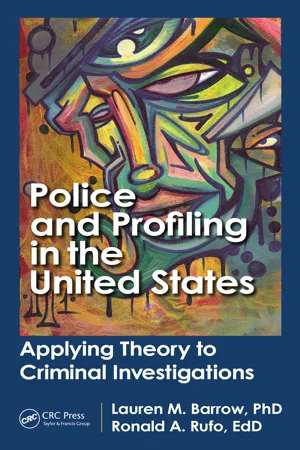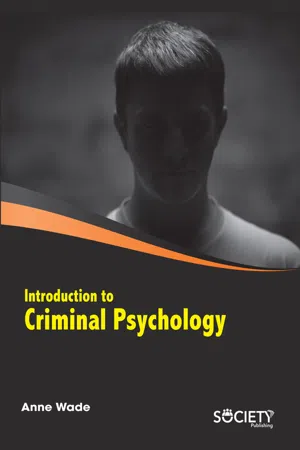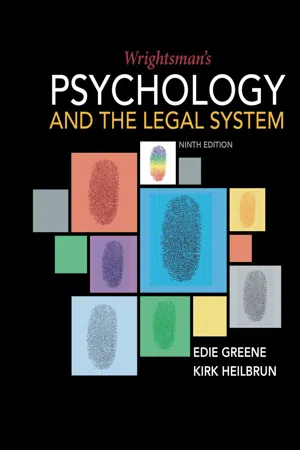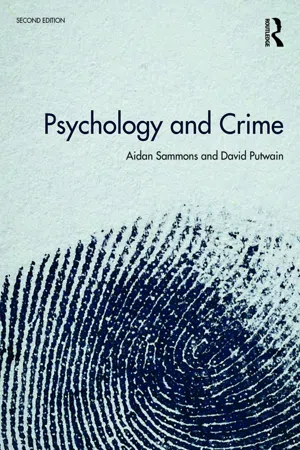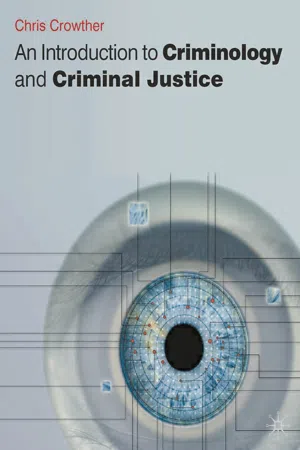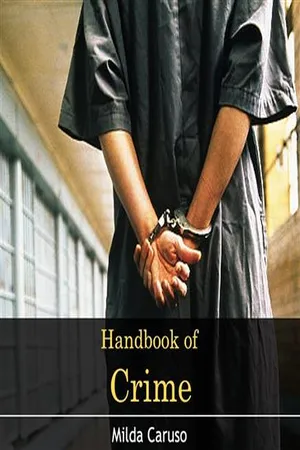Psychology
Types of crime
Types of crime refer to the various categories of criminal activities, such as violent crimes (e.g., assault, murder), property crimes (e.g., theft, burglary), white-collar crimes (e.g., fraud, embezzlement), and cybercrimes (e.g., hacking, identity theft). Understanding these types of crime is important in the field of psychology as it helps in studying the causes, motivations, and impacts of criminal behavior on individuals and society.
Written by Perlego with AI-assistance
Related key terms
1 of 5
8 Key excerpts on "Types of crime"
- eBook - PDF
Police and Profiling in the United States
Applying Theory to Criminal Investigations
- Lauren M. Barrow, Ron A. Rufo, Saul Arambula(Authors)
- 2013(Publication Date)
- Routledge(Publisher)
Criminal Event Typologies The typing of crime offers little opportunity for interpretation. The acts them-selves are legislatively or legally defined, which often dictates the category. In essence, “it is what it is.” If one is to consider crime typologies in the broad-est sense of the term, then there are four general categories into which most offenses can be placed (note that these categories are not always independent of one another): violent offenses, property offenses, white collar crime/orga-nized crime offenses, and public order/victimless offenses (level 1). Table 5.2 shows specific crimes categorized into the appropriate category (level 2), and beyond that typology, various methods of committing those crimes can be typed (level 3), and then finally, the various methods of com-mitting the crimes categorized (level 4). 77 Motives and Criminal Typologies Criminal Offender Typologies Beyond the categorization of the crime itself, offenders are also categorized into general types. The typing of offenders serves many purposes, not the least of which includes providing a framework for disposition (i.e., rehabili-tation vs. retribution) or potentially setting the direction for identifying an unknown suspect, (i.e., serial offender vs. opportunistic offender). There are many continuums along which specific offenders can be categorized; a list of the more common typologies is provided below. Types of Offenders Homicide, sexual assault, and child investigations often encompass a vari-ety of explicit crime scene characteristics that are specific to the crime, the victim(s), and the relationship with the offender. Different types of offenders will often exhibit different behavioral patterns, for example: • An unknown (stranger) vs. - eBook - PDF
- Anne Wade(Author)
- 2020(Publication Date)
- Society Publishing(Publisher)
Theories of Criminal Behavior 7 CONTENTS 7.1. What Is Criminal Behavior And Why Do People Commit Crimes? ... 172 7.2. Biological Theories Of Crime .......................................................... 173 7.3. Sociological Theories Of Criminal Behavior .................................... 183 7.4. Psychological Theories Of Criminal Behavior .................................. 196 Introduction to Criminal Psychology 172 7.1. WHAT IS CRIMINAL BEHAVIOR AND WHY DO PEOPLE COMMIT CRIMES? There are several questions that can be answered when thinking and responding to criminal behavior. Some of the questions include whether there is a single theory that can be used in the explaining criminal behavior. What is the difference in the explanation of criminal behavior and its prediction? How does criminal behavior differ from human behavior that is considered normal? Can a single type of criminal behavior be a result of different forms of motivation? Do different crimes have specific features? Does gender, culture or time period influence the Types of crimes committed by individuals and finally is crime a measurable and how can it best be measured? All these questions point out the fact crime is a complex concept and that there are no simple answers as to why people commit crimes. A lot of public and media attention is usually directed catching, convicting, and punishing those who take part in criminal activities and most of the time people do not stop to ask or answer the question why. However, in the recent years, criminologists have recognized that accurately understanding and predicting criminal behavior needs theoretical and disciplinary integration. Historically, there are different theories that have used when it comes to understanding crime. Most of the time theories are referred to as being good if they provide foundation via which behavior can be understood and interpreted. - eBook - PDF
- Edith Greene, Kirk Heilbrun(Authors)
- 2018(Publication Date)
- Cengage Learning EMEA(Publisher)
Alternatively, criminal behavior may appear to result from an individual’s biological characteristics. Biological theories of crime stress genetic influences, neuropsychological abnormalities, and biochemical irregularities. But as we shall see, there is little empir-ical evidence that either sociological or biological the-ories independently predict criminal behavior. Instead, current theories of crime incorporate a combination of environmental and biological factors to understand the causes of offending behaviors. Some psychological theories emphasize that crime results from personality attributes that are uniquely possessed, or possessed to a special degree, by the potential criminal. For example, some psychological approaches have focused on patterns of thinking— particularly with respect to recognized risk factors such as pro-criminal attitudes or certain kinds of personal-ity disorders. Others focus on intellectual functioning or cognitive and social development (Moore, 2011). Social–psychological theories (Arrigo, 2006) bridge the gap between the environmentalism of sociol-ogy and the individualism of psychological or biologi-cal theories. Social–psychological theories propose that crime is learned, but they differ from sociological and psychological theories in about what is learned and how it is learned. Copyright 2019 Cengage Learning. All Rights Reserved. May not be copied, scanned, or duplicated, in whole or in part. Due to electronic rights, some third party content may be suppressed from the eBook and/or eChapter(s). Editorial review has deemed that any suppressed content does not materially affect the overall learning experience. Cengage Learning reserves the right to remove additional content at any time if subsequent rights restrictions require it. Theories of Crime as Explanations of Criminal Behavior 53 Sociological Theories of Crime Sociological theories may be divided into structural and subcultural explanations . - Anne Wade(Author)
- 2020(Publication Date)
- Society Publishing(Publisher)
Hate Crime 4 CONTENTS 4.1. Introduction ...................................................................................... 52 4.2. Roles Played By Criminal Psychologists ............................................ 52 4.3. Crimes That Occur Around Hate Crime ............................................. 53 4.4. Types of Assault That Hate Crime Brings ............................................ 56 4.5. Advantages of Criminal Psychology In Hate Crime ............................ 63 Application of Criminal Psychology in Different Types of crimes 52 4.1. INTRODUCTION Criminal psychology involves the study of criminal thought, behavior, thoughts, reactions, and motives and all matters concerning criminal conduct. This explores why a person committed a crime and the reactions after he committed a crime. Such forensic psychologists are active in the investigation process before or during the trial. At court, they can be summoned to give their views and help the judge and the jury understands what is going on in the minds of a criminal. Among the cases covered by criminal psychology is the area of hate crime. 4.2. ROLES PLAYED BY CRIMINAL PSYCHOLO-GISTS The criminal psychologist plays some roles. They can be involved as an evaluator in the situation. They assess the alleged victim and perpetrator in this area. In the assessment, they discuss the individual’s characteristics and how they interact with them. We also look at both offenders and victims’ emotional responses. They also determine whether produce or malingering occurs. They also conduct a recall and intellectual examinations. The cognitive interrogation method is used in criminal psychology. This technique was useful to obtain information (Brewer, 2000). They may also play a therapeutic role. Most criminal psychologists have licenses to provide these services. The criminal psychologist explores the mental dimension of abuse as a therapist. The rewards are both from the suspected perpetrator and the victim.- eBook - PDF
Psychology and Crime
2nd edition
- Aidan Sammons, David Putwain(Authors)
- 2018(Publication Date)
- Routledge(Publisher)
This being the case, it is difficult to see how consensus could be achieved among researchers about the acts they ought to be studying. Different researchers resolve this issue in different ways but many follow the suggestions of Blackburn (1993) who makes several useful recommendations. First, ‘criminal behaviour’ should be defined in terms of the conscious breaking of rules. That is, the people of interest to criminological psychology are those who know what the rules are, but do something different. This inevitably means that some chapter 2 Defining and measuring crime 8 behaviour that is legally permissible is nonetheless of interest to psychologists and criminologists whereas other behaviour that is technically criminal is not. So those who park their cars in the spaces reserved for parents with children are not com-mitting a crime but might still be of interest because there is an underlying simi-larity between this act and other acts that are illegal. This approach allows us to recognise the continuity between, for example, conduct problems in childhood and later delinquency and criminality in adolescence and adulthood. Second, Blackburn recommends that criminological psychology should focus, in the main, on crime as legally defined. The problems this raises notwithstanding, it at least offers research-ers a clear framework on which they can agree. The majority of ‘mainstream’ criminological psychologists accept this but not all. Those who adopt one of the more critical perspectives on criminological psy-chology take issue with this apparent willingness to admit, on the one hand, that ‘crime’ and ‘criminal’ are social constructs but, on the other hand, treat them as if they were natural or objective facts. Critical perspectives raise questions about how the social construction of crime relates to issues of power, gender and race in society (see Chapter 12). - Chris Crowther-Dowey(Author)
- 2017(Publication Date)
- Red Globe Press(Publisher)
PART FOUR Theories of Crime INTRODUCTION Many theories of crime have centred on the individual, ranging from those emphasizing the human subject as a free agent (such as classicism and rational choice theory) to ones that suggest individuals are driven to commit crime by their innate characteristics (such as biological and psychological positivism). The first part of the chapter considers the nine-teenth-century legacy, including classicism and positivism. The second part introduces a selection of psychological perspectives. The third part revisits classicism, with a focus on right realist, control and rational choice theories. At the end of this section labelling theory is addressed. This is a unique perspective on the individual offender which does not have a strong fit with either classical or positivist approaches. This prepares for the next chapter, which is dedicated to macro-level theories. The chapter uses various examples from the existing literature, and towards the end reflects on the policy implications of these different theoretical approaches for the criminal justice system. Theories of Crime I: The Individual and Crime 11 OVERVIEW The aim of this chapter is to provide: ឣ an explanation of the main features of theories of crime that focus on the individual ឣ an understanding of individualistic approaches belonging to the classical school, where the emphasis is on free will and the rational human actor ឣ an appreciation of individualistic approaches where the focus is on the influence of biological and psychological factors ឣ an overview of the various models available for explaining the relationship between criminality, the individual and society ឣ an overview of individualistic approaches. THE INDIVIDUAL AND CRIME This section: ឣ introduces a range of approaches used to explain crime by focusing on the individual offender ឣ identifies two broad approaches, positivism and classicism.- eBook - PDF
Criminal Profiling
An Introduction to Behavioral Evidence Analysis
- Brent E. Turvey(Author)
- 2011(Publication Date)
- Academic Press(Publisher)
First, there are those who desire to reveal in the darker sides of human behavior. Second, there are those who need to classify criminals in such a way that they are separate from us ; that they are not the same as we . CHAPTER 10 Criminal Motivation 274 It reduces the suspect pool to those individuals with a particular motive. It assists with the investigative linkage of unsolved crime with a similar motive. Along with other class evidence (i.e., means, opportunity, associative evidence), motive can provide circumstantial bearing on offender identity. Along with other contextual evidence, motive can provide circumstantial bearing on offender state of mind. Along with circumstantial evidence, motive can provide circumstantial bearing on whether a crime has actually occurred. The act or behavior that is proof, or an element of, a crime is referred to as Actus Reus . On this subject, Leonard (2001, p. 489) offers some insight: In the typical criminal prosecution, there is ample evidence that the underlying criminal act occurred.… But sometimes there is a legitimate dispute about the occurrence of the act. Perhaps the alleged murder victim’s body was never found, leaving doubt as to whether any killing took place. Or perhaps the condition of the body did not attest to the cause of death, whether natural, self-inflicted, or by the act of another. Moreover, there are some types of cases in which the lack of physical evidence or disinterested witnesses makes the commission of the criminal act a matter of dispute. This is obviously the case with charges of incest or other types of sexual crimes, though it can be true of other crimes as well. In any case in which the commission of the criminal act by any party is disputed, evidence that the person charged with the act had a motive to commit it can, in theory, be admissible to prove that the act occurred. - No longer available |Learn more
- (Author)
- 2014(Publication Date)
- University Publications(Publisher)
________________________ WORLD TECHNOLOGIES ________________________ Chapter- 2 Types of crimes Property crime Property crime is a category of crime that includes, among other crimes, burglary, larceny, theft, motor vehicle theft, arson, shoplifting, and vandalism. Property crime only involves the taking of money or property, and does not involve force or threat of force against a victim. Although robbery involves taking property, it is classified as a violent crime, as force or threat of force on an individual that is present is involved in contrast to burglary which is typically of an unoccupied dwelling or other unoccupied building. Property crimes are high-volume crimes, with cash, electronics (e.g. televisions), power tools, cameras, and jewellery often targeted. Hot products tend to be items that are concealable, removable, available, valuable, and enjoyable, with an ease of disposal being the most important characteristic. Types of property crime Burglary Burglary of residences, retail establishments, and other commercial facilities involves breaking and entering, and stealing property. Attempted forcible entry into a property is also classified as burglary, in the FBI's Uniform Crime Reports (UCR) definition. As of 1999, there were 1.4 million residential burglaries reported in the United States, which was a record low number, not seen since 1966. Though, up to 50% of burglaries are not reported to the police. The clearance rate for burglary is low, with only 12.7% of cases being solved in the United States in 2005, and 23% in the United Kingdom. In the United States, burglary rates are highest in August and lowest in February, with weather, length-of-day, and other factors having an effect on rates. Fall and Winter are peak seasons for burglary in Denmark. Most residential burglaries occur on weekdays, between 10-11 a.m. and 1-3 p.m, when homes are the least likely to be occupied.
Index pages curate the most relevant extracts from our library of academic textbooks. They’ve been created using an in-house natural language model (NLM), each adding context and meaning to key research topics.
